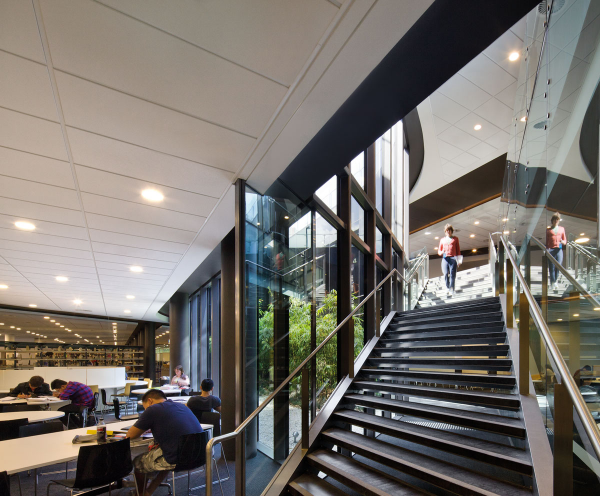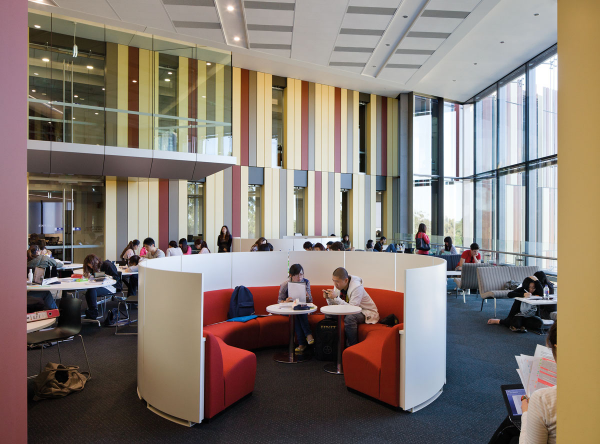








Image Credit : John Gollings
Project Overview
The new library at Macquarie University is an innovative, welcoming and inspiring landmark building for the University. It represents a new generation of library design — full of dynamic, collaborative, open spaces for learning, rather than traditional notion of a library as a quiet, storage facility for printed materials. The transparent and inviting forms of the building open to embrace and define the new University Common, welcoming students, staff and the public to this new place of learning. It is a radical new library characterised by new opportunities for learning, exchange and interconnection, filled with natural daylight, fresh air and landscape.
The arrangement of the built form itself creates an extension of the natural parkland ground plane over the podium. The design puts the majority of the open collection which require no natural light below ground. In this way the open space of the university is extended and enhanced while the form of the new building becomes more human and accessible in scale. It brings the landscape into the building, reflecting natural daylight and shelters in a way that is directly inspired by the forest of eucalypts on the campus.
Project Commissioner
Project Creator
Francis-Jones Morehen Thorp (fjmt)
Team
Architect: Francis-Jones Morehen Thorp
Richard Francis-Jones, Jeff Morehen, Christine Kwong, Simon Barr, Michelle Ho, Phillip Pham, Damian Campanella, Marcel Pradella, Camille Sargent, Eric Lee, Lillian Lau
Landscape Architect - Francis-Jones Morehen Thorp
Matthew Todd, Richard Tripolone
Structural and Civil Engineer - Taylor Thomson Whitting
Mechanical, Electrical, Lighting, Communication, Security & Vertical Transportation Engineers - Steensen Varming
Hydraulic & Fire Services - Warren Smith & Partners
Fire Engineering & BCA - Stephen Grubits & Associates
Acoustic Engineer - Acoustic Studios
Quantity Surveyor - Davis Langdon
Access - Accessibility Solutions
Planning - JBA Urban Planning
Geotechnical Engineer - Douglas Partners
FFE Consultant - Woods Bagot
Structural and Civil Engineer - Taylor Thomson Whitting
Mechanical, Electrical, Lighting, Communication, Security & Vertical Transportation Engineers - Steensen Varming
Hydraulic & Fire Services - Warren Smith & Partners
Fire Engineering & BCA - Stephen Grubits & Associates
Landscape Architect - Francis-Jones Morehen Thorp
Acoustic Engineer - Acoustic Studios
Quantity Surveyor - Davis Langdon
Access - Accessibility Solutions
Planning - JBA Urban Planning
Geotechnical Engineer - Douglas Partners
FFE Consultant - Woods Bagot
Project Brief
The University’s aspirations for the new library building as a key campus facility and as a 21st Century learning environment are embodied in the following principles:
1. High profile building symbolising a “new beginning” at Macquarie - The key design concepts for the building comprise: light and connection; and strong sense of place.
2. Primary focus on client space - learner-centred design with 3,000 flexible, configurable study spaces based on new approaches to learning space design for new generations of students, including students with special needs, researchers and postgraduate students; and 24/7 operation –achieved with different building zones and minimisation of separate service
3. Secondary focus on physical collections - Incorporation of an automated storage and retrieval system (ASRS) for 1.8 million physical volumes to reduce the floor space required by the print collections and improve service delivery and open access shelving for 450,000 - 500,000 physical volumes.
4. Environmentally sustainable design with low maintenance costs and durable finishes with an objective to achieve 5 Stars Greenstars Education Tool.
Project Innovation / Need
The new Library includes Australia’s first automated document storage and retrieval system that allows the same volume of material (1.8 million books) to be stored in the new building in about one-seventh of the original floor space. Eighty per cent of Macquarie’s collection will be housed in this automated collection system.
The arrangement of the built form has been configured to extend the natural parkland ground plane over the podium. The design puts the majority of the open collection which require no natural light below ground. In this way the open space of the university is extended and enhanced while the form of the new building becomes more human and accessible in scale. It brings the landscape into the building, reflecting natural daylight and shelters in a way that is directly inspired by the forest of eucalypts on the campus. This also allows the incorporation of significant green roofs for water harvesting
It is a radical new type of library characterised by opportunities for learning, exchange and interconnection, filled with daylight, fresh air and landscape. Generous atrium walkways and spaces connect all levels and facilitate formal and informal knowledge exchange between students, researchers and staff.
Design Challenge
The main challenge for the building design is to embody the University’s aspiration while providing for the following: demanding briefed accommodation; constraints of the project budget; the principles defined by the Campus Development Plan and a tight delivery programme.
While the new library represents a new beginning for Macquarie University, it is very different to the existing campus built form. The landmark quality and radical form ensure the new library will stand apart, while clearly ‘belonging’ and enhancing this beautiful and uniquely Australian Campus.
The incorporation of Australia’s first automated document storage and retrieval system means there were no local experience or precedents on this component. Challenges lie in the timely coordination with overseas specialist to ensure the delivery of the brief and integration to the architecture.
The unique requirements of this brief inspired a design of layered spatial zones with key components of the library strategically distributed and structured vertically over the built form. These arrangements presented various challenges in relation to equity, natural daylight and acoustical considerations etc. Balancing between the aspiration of a new library which is open and transparent, but appropriate to its function.
In addition to a tight budget and programme, another main challenge is the process to achieve sustainability within the constraints of not having a recognised environmental performance rating system for education buildings at the time of design, but with the client brief for the project reached a 5 star Green Star rating at completion.
Sustainability
The design was inspired by the beautiful natural landscape and parklands of Macquarie University. The extension of this inspiration was to create a new standard of sustainable design for university libraries that is cost effective and of maximum benefit to users.
The project includes rainwater collection, storage, treatment and re-use systems, air cooled plant and water efficient environmental control systems to significantly reduce required water use. One of the largest green roofs for education building in Australia, the rainwater harvesting system alone saves over half the required water supply from Sydney Water.
The energy systems of the building were designed to achieve significant savings in mains power requirements. This was achieved through the use of modest independent energy generation and importantly through an integrated response to the primary power draws of air-conditioning and lighting. When combined with the integration of passive systems such as mixed mode ventilation, Bio-filtration, possible use of a geothermal field (with consequential water loss minimisation), and night purge systems, significant and measurable savings in power requirements were achieved.
There was no recognised environmental performance rating system for education buildings at the time of design. The design team has therefore used the Green Star Education Pilot and the Green Star Office Design Rating Tool as an objective guide to best practice to reach a 5 star Green Star rating at completion.
Sustainability for this new library is achieved not just environmentally, but socially, creating a place that is welcoming, inclusive, and equitable.
Interior Design - Public or Institutional
This award recognises building interiors, with consideration given to space creation and planning, furnishings, finishes and aesthetic presentation. Consideration given to space allocation, traffic flow, building services, lighting, fixtures, flooring, colours, furnishings and surface finishes.
More Details

